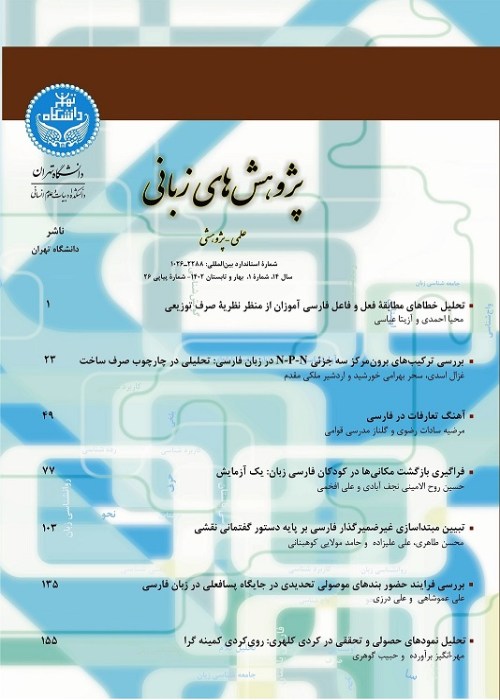A Survey Analysis of the Use of Kurdish Kinship Terms and Persian Borrowed Equivalents (Based on Data from Kalhori Kurdish)
Author(s):
Article Type:
Research/Original Article (دارای رتبه معتبر)
Abstract:
This study set out to examine the use of Kurdish kinship terms comparing with Persian borrowed equivalents in Kalhori Kurdish. Matras (2009), Treffers-Daller (2010) and Muysken, (1987) were frequently cited and adopted as theoretical model. Methodologically, this study is quantitative and descriptive. To achieve the goals, a list composed of almost all Kurdish kinship terms together with Persian borrowed equivalents were distributed among the participants to choose from. Based on gender, age and educational backgrounds, the subjects were divided to eight groups: young male/ female educated; old male/ female educated; young male/ female uneducated; old male/ female uneducated participants. For each group, 10 people were selected randomly. Therefore, a total number of 80 participants were selected to respond to the provided list through interview. For each kinship term, different contexts were provided and then the participants were asked to choose either the local kinship term or the borrowed one from Persian. To analyze the data, SPSS (version 23) was employed. As for the statistical test, ANOVA was employed to find any meaningful relation between the three independent variables of the study (age, gender and educational background) and the participants’ choice among the Kurdish kinship terms and Persian borrowed ones (dependent variable). Unlike the predictions of the theory of borrowing hierarchy (Muysken (1987), the results indicated the Kurdish kinship terms were used much more frequently than their (more prestigious) Persian equivalents in Klahori Kurdish. Different groups employed at least 54.5% to 100% Kurdish kinship terms. Since, no Kurdish lexical gap was found in the provided list, the results were in line with the predictions of the theory of lexical gap (Matras, 2009). Regarding the attested variations among different groups, the statistical employed test (ANOVA) showed that education and age play a meaningful role, while, sex was found to be statistically insignificant.
Keywords:
Language:
Persian
Published:
Language Research, Volume:11 Issue: 1, 2020
Pages:
49 to 72
https://magiran.com/p2198723
دانلود و مطالعه متن این مقاله با یکی از روشهای زیر امکان پذیر است:
اشتراک شخصی
با عضویت و پرداخت آنلاین حق اشتراک یکساله به مبلغ 1,390,000ريال میتوانید 70 عنوان مطلب دانلود کنید!
اشتراک سازمانی
به کتابخانه دانشگاه یا محل کار خود پیشنهاد کنید تا اشتراک سازمانی این پایگاه را برای دسترسی نامحدود همه کاربران به متن مطالب تهیه نمایند!
توجه!
- حق عضویت دریافتی صرف حمایت از نشریات عضو و نگهداری، تکمیل و توسعه مگیران میشود.
- پرداخت حق اشتراک و دانلود مقالات اجازه بازنشر آن در سایر رسانههای چاپی و دیجیتال را به کاربر نمیدهد.
In order to view content subscription is required
Personal subscription
Subscribe magiran.com for 70 € euros via PayPal and download 70 articles during a year.
Organization subscription
Please contact us to subscribe your university or library for unlimited access!


